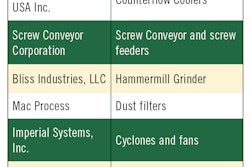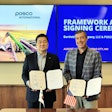
Southeast Asia will have to embrace genuine trade liberalization, in all aspects — sanitary and phytosanitary (SPS) measures and import authorizations, in addition to tariff removals — if it wishes to see its full potential for food security and economic prosperity. Currently, non-tariff trade barriers (NTTBs) are becoming the norm, as nations are willing to liberalize on paper, but not on the ground.

But beyond trade agreements like the ASEAN Economic Community and Trans-Pacific Partnership (TPP) and military conflicts that often dominate the headlines, NTTBs — a nagging and irritating nuance of trade — continue to hamstring the region. These barriers can range from highly secretive quota allocations to a cumbersome import permitting system and myriad other unofficial and official barriers.
The U.S. Grains Council (USGC) is working to help mitigate and even remove these barriers to give the U.S. coarse grains industry the best possible access to this increasingly profitable, vibrant and dynamic market.
Home to the world’s fastest growing economies
Southeast Asia’s cultures and cuisines are as diverse as the people themselves. Vietnam sees itself as eventually surpassing China as the world’s largest per capita consumer of pork. Meanwhile, Malaysia, a predominately Muslim country, is one of the world’s highest per capita consumers of chicken.
The driver of this increased consumption of animal protein is economics. More and more Southeast Asians are seeing themselves being lifted out of poverty, thanks to the great arbitrage in labor: As China’s wages increase, more companies are moving the production of textiles, trinkets and toys to Southeast Asia. This is putting more disposable income in the pockets of citizens, and they love spending it on meat.
However, while Southeast Asia’s demand for meat continues to grow, the region’s ability to produce the coarse grains they need to feed livestock is facing many challenges. From adverse weather to the lack of post-harvest infrastructure to shrinking arable land resources, the region’s grain farmers are unable to meet the local growing demand for coarse grains.
These combined factors offer significant growth opportunities for coarse grain and co-product exports to the region. As Southeast Asia continues to gain importance in the era of globalization, the region and trading partners are in the process of negotiating high-level trade agreements.
One example is the ASEAN Economic Community, a multilateral agreement based on the European Union and designed to provide for greater economic integration and a freer flow of goods and people. It was scheduled to take full effect at the end 2015, although many experts were skeptical whether or not it will truly be implemented in its intended form.

Despite these high-profile, multilateral trade agreements that are grabbing the center stage and acting as poster children for globalization, the reality is increasing trade will be much more challenging on the ground. The reasons extend from the plethora of NTTBs.
NTTBs in Indonesia
Take Indonesia as an example. The Indonesian government has been notoriously protectionist and increasingly burdensome for feed grain importers through its manipulation of import permits in order to give preference to domestic production.
According to official statistics, corn production in Indonesia exceeded 19 million tons (748.0 million bushels) in 2014 and has projected to surpass 20 million tons (787.4 million bushels) in . Compare that with the U.S. Department of Agriculture’s (USDA’s) projections that call for 8.8 million tons (346.4 million bushels) and 9.6 million tons (377.9 million bushels), respectively, and you have quite a discrepancy to reconcile.
This tremendous gap in production has led the government to some draconian policies to curb the influx of imports in favor of more expensive and poorer quality domestic production, which the USDA and others claim is not there in the first place.
Several industry insiders place Indonesia’s true corn import demand somewhere between 3.5 to 4 million tons (137.7 to 157.4 million bushels) annually. However, this comes with major pushback from the government that reportedly wants no more than 3 million tons (118.1 million bushels) of imports. As a result, the country ceased issuing import permits last year, leaving many vessels in purgatory.
Complicating matters, many Indonesian buyers combine their cargo in shipments. If only one of the buyers fails to obtain his or her import permit, the ship sits and collects demurrage that can amount to billions of rupiah. Luckily, the daily charter for vessels is historically low; otherwise, the problem could be much worse.
As history shows us, in the end, capitalism always prevails. In a free market, intelligent and sophisticated feed formulators will always look for the least cost ration. No commodity has a corner on any segment of the ration, energy or amino acid. As a result, the Council is aggressively promoting distiller’s dried grains with solubles (DDGS) to Indonesia buyers and end-users to help provide alternative solutions for feed millers, particularly in the layer and broiler industries. 
NTTBs in Vietnam
While Indonesia’s import hurdles may be burdensome, they certainly aren’t the exception. In the case of Vietnam, instead of being a solution, DDGS are caught squarely in the cross hairs. For more than three years now, Vietnam’s plant protection department has required DDGS to be fumigated because of the presence of a common insect — Trogoderma Inclusum LeConte, or larger cabinet beetle.
Vietnam is only one of five countries in the entire world that classifies this insect as a quarantined pest and the only country that requires 100% origin fumigation. This has prompted Vietnamese importers and end-users to speak out on the burdensome and costly regulations imposed by their government, for which they are eventually forced to pay.
Ultimately, this issue reduces DDGS’ competitiveness in Vietnam, and the Council is continuing its engagement to help understand the government’s position and offer more pragmatic and commercially-adaptable alternatives to this policy.
Overcoming NTTBs
Implementing TPP is a no brainer, not just because of its impact on tariff eliminations but also because of its provisions addressing NTTBs in the Southeast Asian region.
A pillar of the historic TPP agreement will rightfully address technical barriers to trade like SPS measures. According to the official chapter on SPS measures:
“The SPS chapter designs new rules that will ensure that science-based SPS measures are developed and implemented in a transparent, predictable and non-discriminatory manner, while at the same time preserving the ability of U.S. and other TPP regulatory agencies to take necessary steps to ensure food safety, and protect plant and animal health.”
This is a step in the right direction, but more needs to be done. These growing pains should be merely a bump along the road of the region’s global ascension. If Southeast Asian nations are serious about providing food security and safety to the masses, they must be more transparent with quota allocations, permits and other barriers to trade.
Free markets must be allowed to allocate resources, and the private sector should be the engine that drives these markets. Science — not politics and fear — should be the foundation for establishing risk parameters for food and feed safety. The Council is here to help on these measures.

As we often say, when trade works, the world wins. ❚
Editor’s note: U.S. Grains Council is online at www.grains.org. Readers can sign up for the USGC weekly newsletter at http://usgc.informz.net/USGC/profile.asp.


















